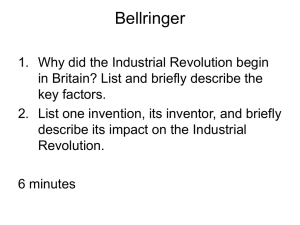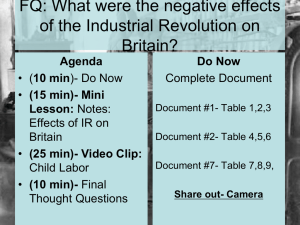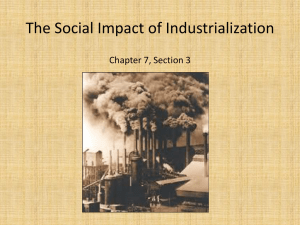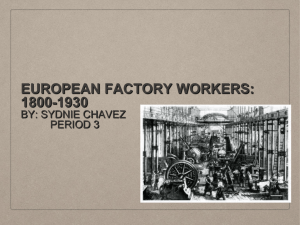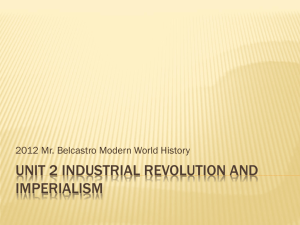Industrial Revolution
advertisement
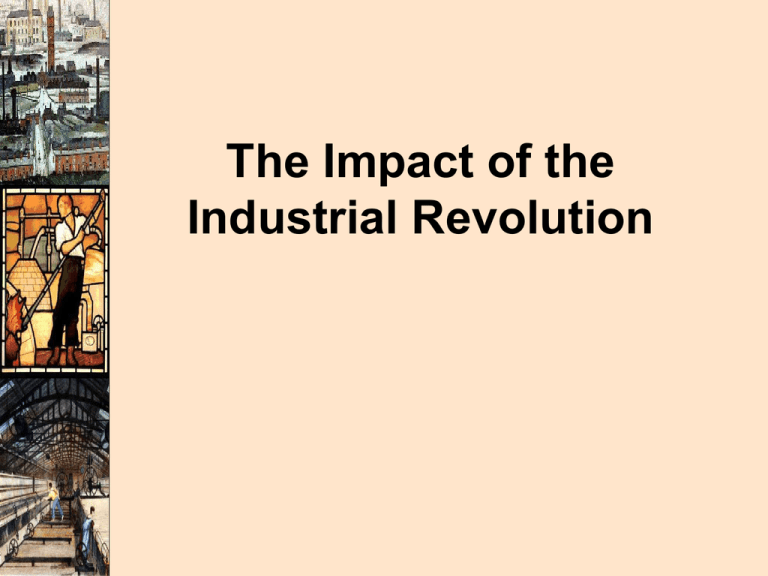
The Impact of the Industrial Revolution Working Conditions and Wages Working Conditions and Wages • The factory system was a major change for European workers: Factory work became less skilled Factory conditions were dirty, dangerous, and unhealthy Workers worked long hours (12-16 hr day) Factory workers were not paid well; Women & children were paid less than men Owners required workers “clock in” & limited their breaks to increase production Conditions in the Coal Mines Conditions in Coal Mines • The invention of the steam engine increased demand for coal: Coal production grew from 5 million tons in 1750 to 23 million tons in 1830 Men, women, children were used in mines Mines were unhealthy & dangerous: Lung disease, poison gas, drowning, explosions cave-ins were common for workers Child Labor Child Labor • The Industrial Revolution changed the lives of many children: Rather than working for their parents on family farms, many children in the cities worked in factories, brickyards, or mines Living in cities was expensive so poor families needed their kids to work Child workers earned 10% of an adult wage, worked long hours in dangerous conditions, were often beaten Changing Role of Women Changing Role of Women • The Industrial Revolution changed the lives of many women: Rather than working with their husbands on family farms and taking care of children, poor women in cities worked in factories Some women worked as domestic servants Factory jobs for women required long hours away from their children and could leave women crippled, sick, or deformed Women were paid ½ or ⅓ of a man’s salary Urbanization Urbanization • Urbanization increased dramatically: The increase in population and enclosure of farms forced people to move to cities Poor families lived in poorly constructed apartments built by factory owners called tenements in neighborhoods called slums Many families shared cramped apartments that lacked running water or sanitation Hard factory jobs and disease led to short life expectancies for urban workers Changing Class Structure Changing Class Structure • During the Industrial Revolution, the social class system changed as ownership of land stopped being the most important factor: At the top were the industrial capitalists who gained wealth by owning factories The middle class grew because of growth of engineers, managers, shopkeepers The bottom class grew because of the size of the urban poor who worked for low wages in factories How did people respond to the changes & abuses of the Industrial Revolution? Some demanded reforms to fix problems caused by the Industrial Revolution In the mid-1800s, Britain & the U.S. passed child & women labor laws that limited hours & type of work they could perform Reformers regulated water, food, sewage; Offered public education; Regulated living & work conditions How did people respond to the changes & abuses of the Industrial Revolution? Workers joined unions & When union demands demand better pay, fewer were not met, workers hours, safer work conditions went on strike How did people respond to the changes & abuses of the Industrial Revolution? The economy of the Industrial Revolution was based on capitalism As Adam Smith explained, businesses operated in a free market economy based on competition, profits, supply & demand Governments applied laissez-faire principles & avoided heavy taxes, regulations, or interference in business How did people respond to the changes & abuses of the Industrial Revolution? Some believed that was the reasons for the growing gap between the rich and poor… How did people respond to the changes & abuses of the Industrial Revolution? …and rejected capitalism in favor of socialism Socialists argued that the government should plan the economy by controlling factories, farms, railroads, mines, & important industries This would create equality & end poverty by redistributing wealth from rich capitalists to the poor workers Capitalism vs. Socialism How did people respond to the changes & abuses of the Industrial Revolution? Karl Marx introduced a radical form of socialism called communism Marx & Friedrich Engels wrote The Communist Manifesto which predicted a war between the “haves” & “have nots” Marx encouraged workers to overthrow owners, seize control of factories, distribute goods evenly, & create economic equality for all people Stereotype of the Factory Owner “Upstairs”/“Downstairs” Life Evidence of Textile Workers in Wilson's Mill, Nottingham Hannah Goode: "I work at Mr. Wilson's mill. I think the Mrs. Smith: have three in 20 Wilson's youngest child"I is about 7. I children daresayworking there are under mill; 9 oneIt11, one 13, and thefive other regular years. is about half past by 14. our They clock work at home when there.come We don't complain. theymill. go We to drop thestop we hours go in....We out at seven byIf the never hours, know what people will do. We have to take ourI don't meals, except at poor dinner. hard work to live as it is. ...My husband is of the same William Crookes is overlooker in our room. He is crossmind about it...last summer my husband was 6 weeks ill; tempered sometimes. does not beat me;the hethings beats are the we pledged almost He all our things to live; littlenot children doyet. not ...We do their work right....I havebut all out ifofthey pawn complain of nothing sometimes seen the children little children but not short wages...My havedrop beenasleep in the or millso, three lately. If they are no catched asleep they get the strap. years. I have complaint to make of their beingThey would they were than Ifined." arebeaten...I always very tiredrather at night....I can beaten read a little; can't write. I used to go to school before I went to the mill; I have since I am sixteen." Factory Wages in Lancashire, 1830 Age of Worker Male Wages Female Wages under 11 2s 3d. 2s. 4d. 11 - 16 4s. 1d. 4s. 3d. 17 - 21 10s. 2d. 7s. 3d. 22 - 26 17s. 2d. 8s. 5d. 27 - 31 20s. 4d. 8s. 7d. 32 - 36 22s. 8d. 8s. 9d. 37 - 41 21s. 7d. 9s. 8d. 42 - 46 20s. 3d. 9s. 3d. 47 - 51 16s. 7d. 8s. 10d. 52 - 56 16s. 4d. 8s. 4d. 57 - 61 13s. 6d. 6s. 4d. Industrial Staffordshire The New Industrial City Early-19c London by Gustave Dore Worker Housing in Manchester Factory Workers at Home Workers Housing in Newcastle Today The Life of the New Urban Poor: A Dickensian Nightmare! Private Charities: Soup Kitchens Private Charities: The “Lady Bountifuls” QUESTIONS 1. What do you think happened to younger children when the family was away at work in mills? 2. What might be different about work done at home compared to work in the factory? 3. Why did some workers oppose the imposition of laws restricting women and children's work?


